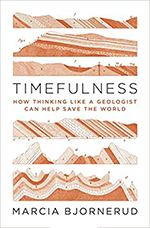[Note: this book review was scheduled to run in the July 2019 issue of EARTH magazine, but with the announcement two weeks ago that EARTH was being shuttered, I was notified that nothing contributors or freelancers had written scheduled for after April 2019 would be published, and the rights were returned to me. While that’s disappointing, it frees me up to publish it here instead. Enjoy!]
_____________________________________________
 Geology is a flavor of science that carries with it a certain philosophical perspective. It imbues its practitioners with a sense of scale. I mean this in the three-dimensional physical sense of the term (geologists deal with very small things like mineral crystal defects, and very large things, such as lithospheric plates), but also in the temporal sense: Geologists must be comfortable with slow rates (“glacial” being the type example, but seafloor spreading is even slower, and also really fast rates, such as slip on faults, or instantaneous rock vaporization during extraterrestrial bolide impacts. This is a useful trait in a species that is otherwise “intemperate and intemporate,” a new book asserts.
Geology is a flavor of science that carries with it a certain philosophical perspective. It imbues its practitioners with a sense of scale. I mean this in the three-dimensional physical sense of the term (geologists deal with very small things like mineral crystal defects, and very large things, such as lithospheric plates), but also in the temporal sense: Geologists must be comfortable with slow rates (“glacial” being the type example, but seafloor spreading is even slower, and also really fast rates, such as slip on faults, or instantaneous rock vaporization during extraterrestrial bolide impacts. This is a useful trait in a species that is otherwise “intemperate and intemporate,” a new book asserts.
Geologists are awesome because they open this vast four-dimensional thoughtspace to human imaginations. In Timefulness: How thinking like a geologist can help save the world, Marcia Bjornerud makes the case that geological thinking is the perspective that can save our species, and the biosphere, if not “the world.”
Marcia Bjornerud is a professor of geology at Lawrence University in Appleton, Wisconsin. She writes periodically for the New Yorker’s science blog, ‘Elements,’ and has published one previous book, the superb 2005 Reading the Rocks. The new book is more political than its predecessor, but equally grounded in the serenity of contemplating data through the lens of Deep Time. Whereas “Reading the Rocks” was about the awesome insights of Earth science, Timefulness is about the relevant insights of Earth science to society. If we don’t know our deep history, Bjornerud argues, we live only in the present, divorced simultaneously from our rich natural heritage and devoid of responsibility for the as-yet-unmanifested results of our actions. By anchoring our human perspective to the broad sweep of cosmogenic evolution and terrestrial changes, we gain the proper ‘sense of where we are,’ unblinkered by short-term delusion or greed.
I love Bjornerud’s writing. She writes like the most engaging professor I have ever had, with a sense of the proper proportion of enthusiasm, the right balance of quantitative measurement and mind-blowing elucidation, expressed in terms that make me swoon. Everything she writes about is big and real and essential. Her vocabulary is expansive and rich, her pacing well-honed. Her analogies are evocative and diverse. Here’s an example, wherein she brilliantly compares old and more recent rocks: “Young rocks communicate in plain prose, which makes them easy to read, by they typically only have one thing to talk about. The oldest rocks tend to be more allusive, even cryptic, speaking in metamorphic metaphor. With patience and close listening, however, they can be understood, and they generally have more profound truths to share about endurance and resilience.”
Golly, that’s beautiful. You can tell that Bjornerud is still blown away by how amazing geological insights are, and she expresses that wonder so wonderfully. In another spot, communicating the impermanence of topographic mountain ranges, she writes, “Majestic peaks and magnificent palisades are simply what remains, for now — the provisional results of the latest cuts by a team of obsessive sculptors: water, ice, and wind in artistic collaboration with gravity.” Her vision of Earth science is poetic and lovely.
A distinctive feature of her writing is numerous small sub-sections to a chapter, each with a pithy subtitle. A few examples: ‘Esprit de Cores’ (about the revelations of deep-sea drilling), ‘Apocalypse Now,’ (about the modern biodiversity crisis), and ‘Knocking on Wood’ (about carbon sequestration by planting trees). This clever wordplay delights me.
What are we humans going to do with ourselves? Our species is clever and powerful, and we have altered the natural cycling of matter and energy in many aspects of the planetary system that supports our existence. Some of these alterations are apparently minor and others are so starkly aberrant that they are difficult to comprehend. At the forefront of Bjornerud’s mind is of course the human-induced relocation of carbon atoms from their sedate position in the sedimentary rocks of Earth’s crust into a new venue: bonded with oxygen, aloft in the troposphere. There, some of them block spacebound emissions of infrared radiation (warming the planet’s surface) and others dissolve in the oceans (lowering its pH). This does not bode well, and the rate of the carbon flux is increasing even as scientists warn against its unintended effects. Bjornerud empowers us to “repeal the Anthropocene” by first coming to terms with the physical reality geoscientists have revealed.
In the end, I feel like I learned more from Bjornerud’s earlier book, but agree 100% with this one, which feels essential and timely. It encapsulates the mismatch between the long-term sense of who we are and where we came from with the short-term-thinking that dominates our election cycles and our stock markets. Recommended to all.

great review